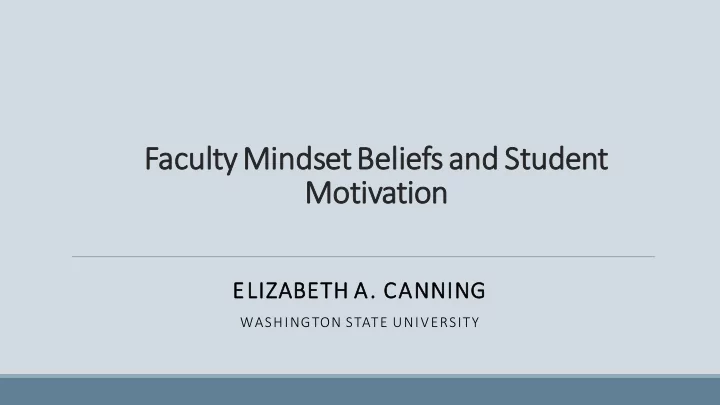

Facul ulty M Minds ndset B Beliefs and nd St Stud udent Motivat ation on ELIZABETH A A. C CANNI NING NG WASHINGTON STATE UNIVERSITY
Mindset Theory Personal beliefs about the malleability or fixedness of ability and talent 1. Fixed Mindset: • Abilities are fixed and can’t be changed Either you have what it takes or you don’t 2. Growth Mindset: • Abilities are malleable • Abilities can improve with effort, learning, and good strategies (Dweck, 1996; Dweck & Leggett, 1988; Molden& Dweck, 2006; Yeager & Dweck, 2012)
Mindset Theory Endorsing fixed mindset beliefs leads to… • Decreased engagement • Decreased persistence • Decreased performance (Dweck, 1996; Dweck & Leggett, 1988; Molden & Dweck, 2006; Yeager & Dweck, 2012)
Personal Beliefs and Consequences Personal mindset beliefs Individual Consequences
Mindset Beliefs and Consequences Mindset beliefs of faculty Social Consequences
Fixed Mindset Beliefs When students endorse fixed mindset beliefs: • only affects individual outcomes When faculty endorse fixed mindset beliefs: • demotivating for everyone in the context • triggers stereotype threat among stigmatized groups Stereotype threat: Risk of confirming a negative stereotype about one’s group leads to lower performance (Steele & Aronson, 1995; Spencer, Steele, & Quinn, 1997)
Faculty Mindset Behaviors Professors with a Fixed Mindset: Place less emphasis on learning and development Encourage struggling students to drop difficult courses Comfort students for their poor performance (e.g., “it’s ok—not everyone is meant to pursue a career in math”) (Rattan et al., 2012; Levy et al., 1998)
Culture of Stereotype Threat Does my Faculty with a fixed mindset may professor think I can do this? create a culture of stereotype threat. Fixed Mindset: majority group > stigmatized groups Growth Mindset: Is my professor majority group ⋍ stigmatized stereotyping me? groups
Research ch: F Faculty M y Mindset Beliefs
Faculty M y Mindset B Beliefs 150 STEM faculty self-reported their mindset beliefs: Two items, adapted from Dweck (1999), α = .91 • E.g., “To be honest, students have a certain amount of intelligence, and they really can't do much to change it.” Canning et al. (2019), Science Advances
Sel elf-reported F Faculty M y Mindset D Distribution 4.7% 26.7% URM Female (Black, Hispanic, Native American) More Fixed More Growth Canning et al. (2019), Science Advances
STEM Departments 4.7% 26.7% URM Female (Black, Hispanic, Native American) Canning et al. (2019), Science Advances
Student Sample We obtained course grades for every student these faculty (N=150) taught over two years (7 semesters). 634 STEM Courses 15,466 undergraduate students • 46.2% female, • 11% URM (Black, Hispanic, Native American) • 14.7% first-generation Canning et al. (2019), Science Advances
Stude udents pe perform worse in n classes taug ught by by faculty w who o endorse e fixed ed ( (vs. g growth) mindset et b belief efs Main effect: b = .08, p = .011 Error Bars = +/- 1 SE Canning et al. (2019), Science Advances
The racial a achievement gap i is twice as large in ST STEMcourses taug ught by by faculty who ho e endo ndorse f fixed ( (vs. g growth)mindset b beliefs Interaction: b = .04, p = .041 Error Bars = +/- 1 SE Canning et al. (2019), Science Advances
Do students e s experience ce t the cl classe sses s differently? We obtained average course evaluations for all courses taught by the faculty members in our sample (four semesters, N = 634 courses). Student-level evaluations were not available due to confidentiality constraints. Canning et al. (2019), Science Advances
Co Cour urse Evaluations: Cl Classroom Cul Culture Scale: 1-5 * p <.05 ** p <.01 Canning et al. (2019), Science Advances
Co Cour urse Evaluations: Cl Classroom Cul Culture Scale: 1-5 * p <.05 ** p <.01 Canning et al. (2019), Science Advances
Co Cour urse Evaluations: Cl Classroom Cul Culture Scale: 1-5 * p <.05 ** p <.01 Canning et al. (2019), Science Advances
Co Cour urse Evaluations: Cl Classroom Cul Culture Scale: 1-5 * p <.05 ** p <.01 Canning et al. (2019), Science Advances
Summa mary Mindset beliefs of faculty have social consequences , impacting everyone in the classroom—particularly those who are stigmatized.
Pract ctical S Steps
What can educators do? • Incentivize learning and development rather than raw ability and performance. • Provide multiple opportunities to demonstrate learning over time • Partial credit for showing process vs. end result • Limit language and policies that identify those believedto be naturally talented. • Reward improvement • Reward challenging oneself
What can educators do? (cont.) • Cultivate a culture centered on developing and improving people’s abilities. • Mistakes are learning opportunities, not something to avoid at all costs • State your mindset beliefs on your syllabus and throughout your course: “I believe that every student can improve their skills, learn from their mistakes, and be successful in this course.”
What can educators do? (Cont.) • Performance Feedback “The first exam grades are now posted. Remember that learning is a process and often occurs over time. I believe that every student can improve their skills, learn from their mistakes, and be successful in this course. Attending office hours is the best way to deepen your understanding of the material and a great opportunity to improve your skills before the next exam.”
Thank yo k you! Email: elizabeth.canning@wsu.edu This work was supported by a NSF CAREER grant awarded to Dr. Mary Murphy.
Recommend
More recommend